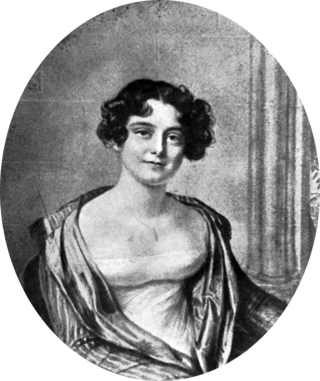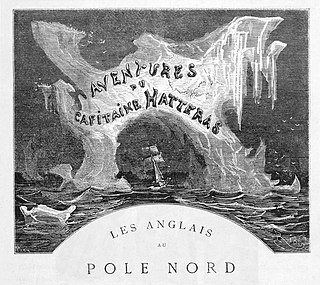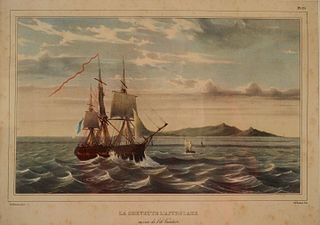
Jules Gabriel Verne was a French novelist, poet, and playwright. His collaboration with the publisher Pierre-Jules Hetzel led to the creation of the Voyages extraordinaires, a series of bestselling adventure novels including Journey to the Center of the Earth (1864), Twenty Thousand Leagues Under the Seas (1870), and Around the World in Eighty Days (1872). His novels, always well-researched according to the scientific knowledge then available, are generally set in the second half of the 19th century, taking into account the technological advances of the time.

Twenty Thousand Leagues Under the Seas is a science fiction adventure novel by the French writer Jules Verne. It is often considered a classic within both its genres and world literature. The novel was originally serialised from March 1869 to June 1870 in Pierre-Jules Hetzel's French fortnightly periodical, the Magasin d'éducation et de récréation. A deluxe octavo edition, published by Hetzel in November 1871, included 111 illustrations by Alphonse de Neuville and Édouard Riou.

Sir John Franklin was a British Royal Navy officer, explorer and colonial administrator. After serving in the Napoleonic Wars and the War of 1812, he led two expeditions into the Canadian Arctic and through the islands of the Arctic Archipelago, during the Coppermine expedition of 1819 and the Mackenzie River expedition of 1825, and served as Lieutenant-Governor of Van Diemen's Land from 1837 to 1843. During his third and final expedition, an attempt to traverse the Northwest Passage in 1845, Franklin's ships became icebound off King William Island in what is now Nunavut, where he died in June 1847. The icebound ships were abandoned ten months later, and the entire crew died from causes such as starvation, hypothermia, and scurvy.

HMS Erebus was a Hecla-class bomb vessel constructed by the Royal Navy in Pembroke dockyard, Wales, in 1826. The vessel was the second in the Royal Navy named after Erebus, the personification of darkness in Greek mythology.

HMS Resolute was a mid-19th-century barque-rigged ship of the British Royal Navy, specially outfitted for Arctic exploration. Resolute became trapped in the ice searching for Franklin's lost expedition and was abandoned in 1854. Recovered by an American whaler, she was returned to Queen Victoria in 1856. Timbers from the ship were later used to construct the Resolute desk which was presented to the President of the United States and is located in the White House Oval Office.

The Mysterious Island is a novel by Jules Verne, serialised from August 1874 to September 1875 and then published in book form in November 1875. The first edition, published by Hetzel, contains illustrations by Jules Férat. The novel is a crossover sequel to Verne's famous Twenty Thousand Leagues Under the Seas (1870) and In Search of the Castaways (1867–68), though its themes are vastly different from those books. An early draft of the novel, rejected by Verne's publisher and wholly reconceived before publication, was titled Shipwrecked Family: Marooned with Uncle Robinson, indicating the influence of the novels Robinson Crusoe and The Swiss Family Robinson. Verne developed a similar theme in his novel, Godfrey Morgan.

The Voyages extraordinaires is a collection or sequence of novels and short stories by the French writer Jules Verne.

In Search of the Castaways is a novel by the French writer Jules Verne, published in 1867–68. The original edition, published by Hetzel, contains a number of illustrations by Édouard Riou. In 1876, it was republished by George Routledge & Sons as a three volume set titled A Voyage Round The World. The three volumes were subtitled South America, Australia, and New Zealand. As often with Verne, English translations have appeared under different names; another edition has the overall title Captain Grant's Children and has two volumes subtitled The Mysterious Document and Among the Cannibals.

Elisha Kent Kane was a United States Navy medical officer and Arctic explorer. He served as assistant surgeon during Caleb Cushing's journey to China to negotiate the Treaty of Wangxia and in the Africa Squadron. He was assigned as a special envoy to the United States Army during the Mexican–American War and as a surveyor in the United States Coast Survey.

HMS Terror was a specialised warship and a newly developed bomb vessel constructed for the Royal Navy in 1813. She participated in several battles of the War of 1812, including the Battle of Baltimore with the bombardment of Fort McHenry. She was converted into a polar exploration ship two decades later, and participated in George Back's Arctic expedition of 1836–1837, the successful Ross expedition to the Antarctic of 1839 to 1843, and Sir John Franklin's ill-fated attempt to force the Northwest Passage in 1845, during which she was lost with all hands along with HMS Erebus.
Beechey Island is an island located in the Arctic Archipelago of Nunavut, Canada, in Wellington Channel. It is separated from the southwest corner of Devon Island by Barrow Strait. Other features include Wellington Channel, Erebus Harbour, and Terror Bay.

Texar's Revenge, or, North Against South is the full title of the English translation of the novel written by the French science-fiction author Jules Verne, and centers on the story of James Burbank, an antislavery northerner living near Jacksonville, Florida, and Texar, a pro-slavery southerner who holds a vendetta against Burbank. Originally published in France in 1887, the book received a tepid reaction upon its release in the United States, partly because of Verne's inexpertise regarding some details of the American Civil War, and has since fallen into obscurity compared to many of Verne's other works.

Jane, Lady Franklin was a British explorer, seasoned traveler and the second wife of the English explorer Sir John Franklin. During her husband's period as Lieutenant-Governor of Van Diemen's Land, she became known for her philanthropic work and her travels throughout south-eastern Australia. After John Franklin's disappearance in search of the Northwest Passage, she sponsored or otherwise supported several expeditions to determine his fate.

The Adventures of Captain Hatteras is an 1864 adventure novel by Jules Verne in two parts: The English at the North Pole and The Desert of Ice.

Astrolabe was a converted flûte of the French Navy, famous for her travels with Jean-François de Galaup, comte de Lapérouse.

Franklin's lost expedition was a failed British voyage of Arctic exploration led by Captain Sir John Franklin that departed England in 1845 aboard two ships, HMS Erebus and HMS Terror, and was assigned to traverse the last unnavigated sections of the Northwest Passage in the Canadian Arctic and to record magnetic data to help determine whether a better understanding could aid navigation. The expedition met with disaster after both ships and their crews, a total of 129 officers and men, became icebound in Victoria Strait near King William Island in what is today the Canadian territory of Nunavut. After being icebound for more than a year, Erebus and Terror were abandoned in April 1848, by which point two dozen men, including Franklin, had died. The survivors, now led by Franklin's second-in-command, Francis Crozier, and Erebus's captain, James Fitzjames, set out for the Canadian mainland and disappeared, presumably having perished.

The Jules Verne ATV, or Automated Transfer Vehicle 1 (ATV-1), was a robotic cargo spacecraft launched by the European Space Agency (ESA). The ATV was named after the 19th-century French science-fiction author Jules Verne. It was launched on 9 March 2008 on a mission to supply the International Space Station (ISS) with propellant, water, air, and dry cargo. Jules Verne was the first of five Automated Transfer Vehicle spacecraft to be launched.

The Flight to France is an adventure novel written by Jules Verne. Set in the year 1792 just before the French Revolutionary Wars, the novel follows fictional French Army Captain Natalis Delpierre. Several English language editions were published with the subtitle, The Flight to France; or, The Memoirs of a Dragoon. A Tale of the Day of Dumouriez.

Sir Allen William Young, was an English master mariner and explorer, best remembered for his role in Arctic exploration including the search for Sir John Franklin.
The Lizard King is a 1988 Australian television film about a woman who comes from France to Australia in search of her son.


















